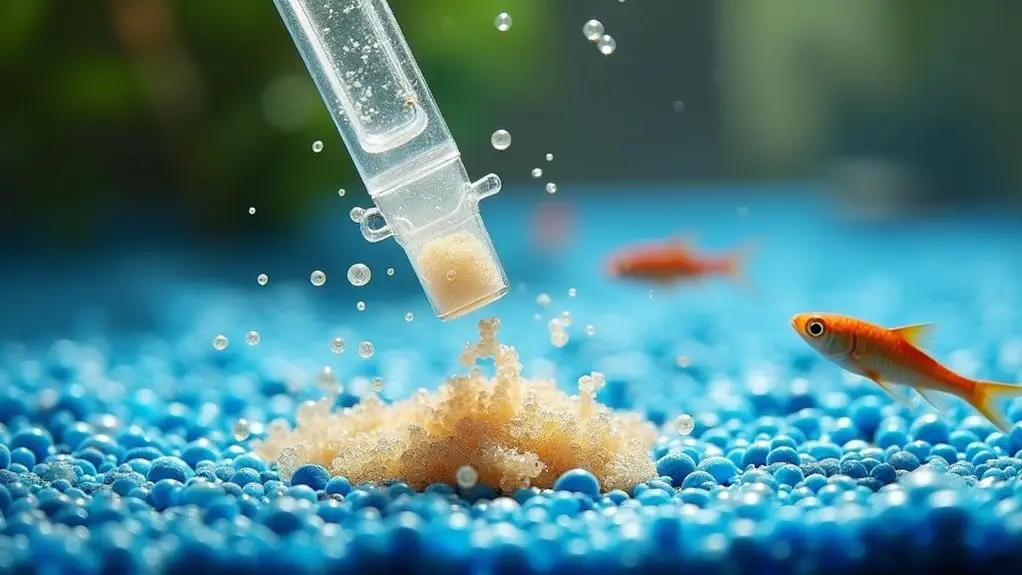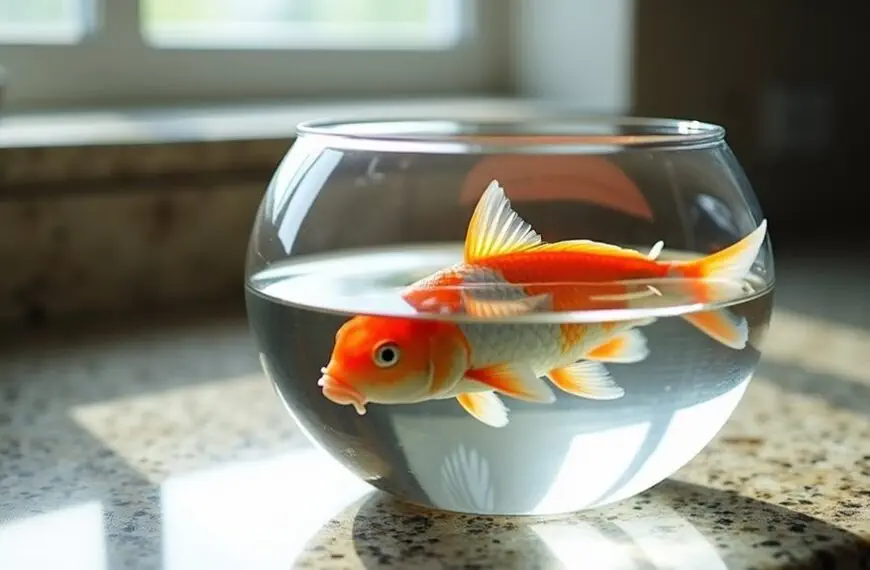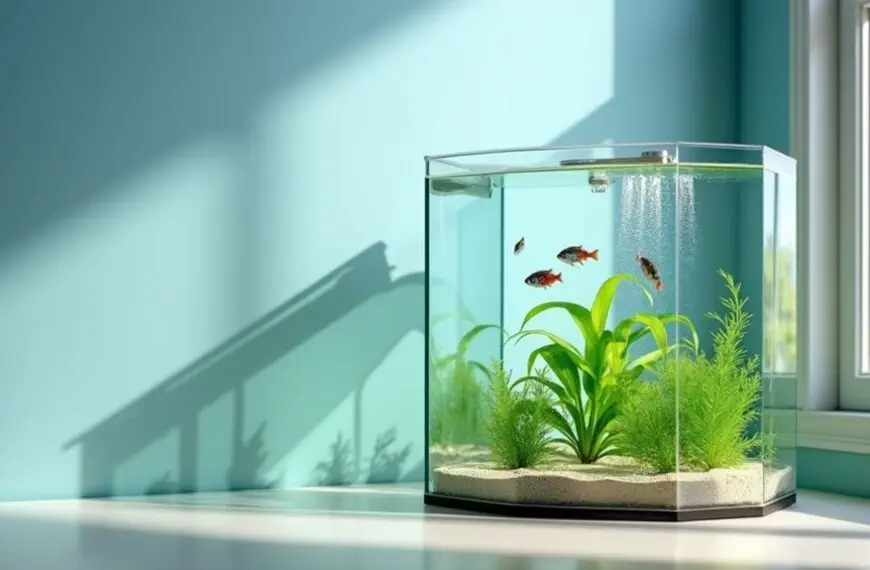You'll need to vacuum your fish tank every 1-2 weeks, though specific needs vary based on your setup. For smaller tanks under 20 gallons, stick to weekly cleaning, while larger tanks over 50 gallons might manage with bi-weekly vacuuming. Keep an eye on visible debris, cloudy water, or fish showing signs of stress – these are clear signals it's time to clean. Your fish population and whether you've got live plants will affect the schedule too. When you're using the right tools and techniques, like a quality siphon and gentle cleaning around decorations, you'll create the perfect environment for your finned friends to thrive.
Contents
- 1 Understanding Basic Tank Maintenance
- 2 Water Quality and Vacuuming
- 3 Signs Your Tank Needs Cleaning
- 4 Recommended Vacuuming Schedule
- 5 Common Mistakes While Vacuuming
- 6 Tank Size Impact
- 7 Fish Population Effects
- 8 Best Tools for Tank Cleaning
- 9 Plant Considerations
- 10 Safety During Tank Maintenance
- 11 Frequently Asked Questions
- 11.1 Can I Vacuum My Tank Immediately After Adding New Fish?
- 11.2 Does Vacuuming Remove Beneficial Bacteria From My Filter System?
- 11.3 Should I Vacuum Differently if I Have Bottom-Dwelling Fish?
- 11.4 How Long Should I Wait to Vacuum After Medicating My Tank?
- 11.5 Can Power Outages Affect My Tank's Vacuuming Schedule?
- 12 Final Thoughts
Understanding Basic Tank Maintenance

Maintaining a healthy fish tank requires a structured approach to cleaning and care across different time intervals. Your tank health depends on a combination of daily, weekly, bi-weekly, and monthly maintenance routines that work together to create the perfect environment for your aquatic friends.
On a daily basis, you'll want to keep an eye on your equipment, check for any fish that might be struggling, and remove leftover food from the surface. Feed your fish only what they consume in 2-3 minutes to prevent excess waste buildup. Using an automatic feeder system can help maintain consistent feeding schedules when you're away. It's like giving your tank a quick morning wellness check! Regular monitoring of water parameters can also help detect issues early.
Weekly maintenance routines kick things up a notch, with significant tasks like water testing, fish counting, and algae removal keeping your underwater world in top shape.
Every two weeks, you'll need to focus on deeper cleaning tasks, including gravel vacuuming and giving those tank walls a good scrub. Think of it as your tank's bi-weekly spa day!
Monthly maintenance is where you'll really dive deep, conducting thorough water tests and checking all your equipment. This layered approach to maintenance guarantees you're not missing any vital aspects of tank care, and your fish will thank you with happy, healthy behavior.
Water Quality and Vacuuming
Three key factors make vacuuming your fish tank essential: water quality, fish health, and overall tank cleanliness. When you vacuum regularly, you're not just making your tank look prettier – you're creating a healthier environment for your finned friends by removing waste that can break down into harmful substances like ammonia and nitrates. Heavily stocked tanks may experience faster waste accumulation, making it crucial to monitor these levels closely.
You'll be happy to know that beneficial bacteria won't be greatly affected by your vacuuming routine. These microscopic helpers primarily live in your filter media and deep within the substrate, so they'll keep doing their important job while you clean. Using a gravity-based mechanism, your siphon effectively removes debris while preserving the beneficial bacteria colonies, which play a vital role in the nitrogen cycle.
Think of vacuuming like sweeping your floor – you're removing the visible dirt while leaving the good stuff intact.
For most tanks, you'll want to vacuum weekly or biweekly, but there's no one-size-fits-all rule. If you've got a smaller tank or lots of fish, you might need to vacuum more often.
Just remember to move decorations aside and work systematically – those fish waste particles love hiding in corners!
Don't worry about stressing your fish during cleaning; they'll get used to your maintenance routine as long as you work gently around them. Regularly observing your fish during cleaning can also help you identify any signs of stress or health issues.
Signs Your Tank Needs Cleaning
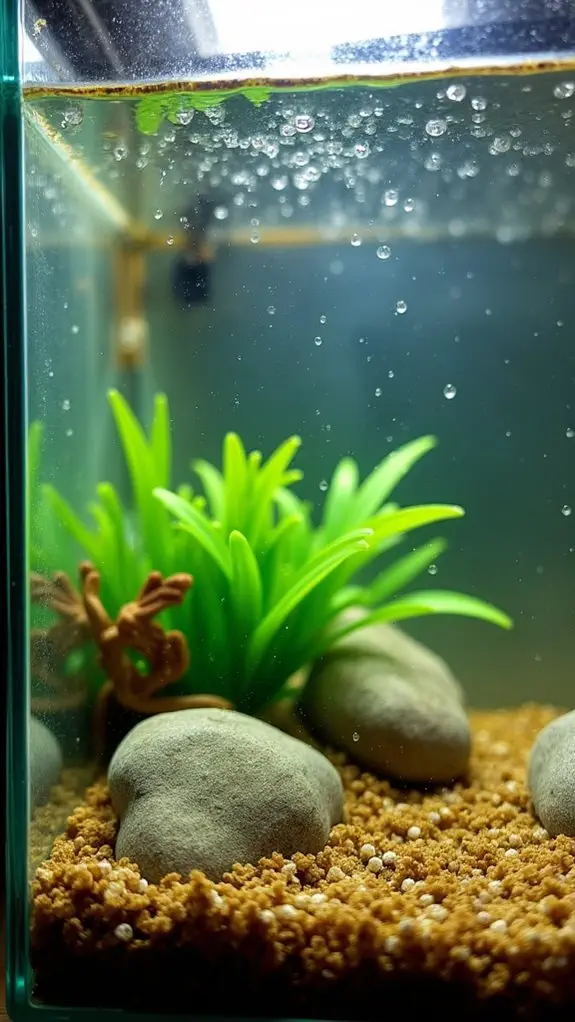
You'll notice one of the first signs that your tank needs vacuuming when you spot waste collecting on the bottom or your water isn't as crystal clear as it used to be.
Visible debris, uneaten food, and fish waste can quickly accumulate in your aquarium, creating an unsightly and unhealthy environment for your finned friends. Poor water conditions can lead to ammonia poisoning in fish, causing severe health issues if left unaddressed. Experts recommend weekly gravel vacuuming while performing regular water changes to maintain optimal tank conditions. Additionally, consistently keeping pH levels stable is vital for a thriving aquatic ecosystem.
When you see these warning signs, especially declining water clarity, it's time to grab your vacuum and give your tank the cleaning it deserves.
Visible Waste Build-Up
Inside every aquarium, visible signs of waste build-up serve as critical indicators that your fish tank needs cleaning. When you're looking at your tank, cloudy or murky water is often your first clue that waste reduction and algae control measures are needed.
You'll notice that excessive algae growth not only looks unsightly but also suggests your tank's ecosystem isn't properly balanced. Regular cleaning is essential since untreated tank issues can lead to fish fatalities. A bi-weekly schedule is typically recommended for maintaining optimal water quality in large, established tanks. Additionally, overfeeding fish can exacerbate waste buildup, making it crucial to monitor feeding habits closely.
Keep an eye out for white, cloudy water, which typically means you've got a bacterial bloom on your hands – usually triggered by high ammonia levels. If you're seeing fungal growth on leftover food or your fish are acting sluggish, that's your tank telling you it's time for action.
Yellow-tinted water and algae coating the glass are also clear signs that your filtration system needs attention.
Don't ignore these warning signs – they're like your aquarium's way of waving a red flag. When you spot any of these indicators, especially if nitrate levels climb above 20 ppm, it's definitely time to break out the vacuum and get to work maintaining your underwater paradise.
Declining Water Clarity
Clear water acts as a window into your aquarium's health, and when that clarity starts to fade, it's time to take notice.
You'll spot several warning signs that your tank needs attention, including cloudy or murky water that doesn't improve even when you adjust the tank lighting. Your fish might show signs of distress too – they could start swimming erratically or gasping near the surface, especially if the water temperature rises due to poor circulation. A monthly full tank cleaning is recommended to prevent these issues from developing. Regular testing for key water parameters like ammonia and nitrites is essential to catch any underlying issues early.
Regular testing using liquid test kits will give you the most accurate readings of your tank's water parameters. Watch out for that unmistakable fishy smell (and not the good kind!) and the unwelcome appearance of algae that seems to pop up overnight.
If you notice your finned friends becoming sluggish, losing their appetite, or doing what looks like an awkward dance against rocks and decorations, they're probably telling you the water quality isn't up to their standards.
Don't wait until these signs appear to take action. Regular tank maintenance, including proper filtration and careful feeding, will help prevent these issues.
Think of it like housekeeping – it's much easier to maintain a clean tank than to rescue one that's gone murky. Your fish will thank you with their vibrant behavior and healthy appetites!
Recommended Vacuuming Schedule
Maintaining a consistent vacuuming schedule is essential for any aquarium's health. Your specific needs will depend on factors like fish population, tank size, and filtration system, but there's a basic schedule that works well for most aquariums.
When you're planning your tank maintenance, consider how your vacuuming techniques and tank accessories might affect your cleaning routine.
Here's a practical schedule to keep your aquarium in top shape:
- Weekly vacuuming for typical home aquariums with average fish populations.
- Twice-weekly cleaning if you've got a heavily stocked tank or feed your fish frequently.
- Every other week for tanks with efficient filtration and active cleanup crews.
- Daily spot cleaning for sensitive species like discus or overstocked tanks.
You'll know you're on the right track when your water stays clear and your fish are active. Regularly vacuuming can help maintain optimal water quality, which is crucial for preventing stress and illness in your fish.
If you're noticing debris building up faster than usual, don't wait for your scheduled cleaning – it's better to vacuum more frequently than risk poor water quality.
Common Mistakes While Vacuuming

Even with a solid cleaning schedule in place, many aquarists make preventable mistakes while vacuuming their tanks. One of the most common errors isn't adjusting vacuuming techniques for different substrate types – what works for gravel mightn't be ideal for sand.
You'll also want to avoid vacuuming too deeply into the substrate, as this can disrupt beneficial bacteria colonies that help maintain your tank's ecosystem.
Another frequent mistake is skipping those hard-to-reach spots under decorations. Let's face it – debris loves to hide there! If you're not lifting those fancy castle ornaments and driftwood pieces during your cleaning routine, you're missing prime real estate for waste accumulation.
And here's something many folks get wrong: not crimping the hose while vacuuming. Without this simple technique, you might accidentally remove too much substrate along with the debris.
Remember to work systematically across your tank's bottom rather than randomly poking around – this guarantees you won't miss any spots. Think of it like mowing a lawn; you wouldn't want to leave patchy areas behind!
Proper vacuuming technique is essential for maintaining a healthy aquarium environment. Additionally, maintaining optimal water parameters is critical for preventing stress and promoting fish health during any cleaning routine.
Tank Size Impact
The size of your fish tank plays a major role in determining how often you'll need to grab that gravel vacuum.
Your small tank's limited space means you'll need to vacuum more frequently (usually weekly), while larger tanks can often go 2-4 weeks between cleanings due to their greater water volume and more stable conditions. It's also important to monitor your tank's bioload regularly, as higher bioloads in small tanks can necessitate more frequent cleaning.
Whether you're maintaining a compact 10-gallon setup or a sprawling 100-gallon aquarium, you'll want to match your cleaning schedule to your tank's specific needs based on its size, fish population, and filtration system.
Space Per Gallon Effects
- Your fish swim side-to-side, not up-and-down, so wider tanks are better than taller ones.
- Each inch of fish needs about 12 square inches of surface area (20 inches for wide-bodied fish).
- Territorial fish need extra space and hiding spots to establish their domains.
- Live plants can help improve water quality but shouldn't be used to justify overcrowding. Additionally, make sure to choose the appropriate tank size to ensure a stable environment and prevent overcrowding as your fish grow.
Cleaning Frequency By Size
Tank size plays an essential role in determining how often you'll need to vacuum your aquarium. Your maintenance schedules will vary considerably depending on whether you're managing a cozy 10-gallon setup or a sprawling 100-gallon underwater paradise.
If you've got a small tank (10-20 gallons), you'll want to be extra diligent with your cleaning techniques. These compact environments need weekly vacuuming since waste can build up quickly in less water.
For medium tanks (20-50 gallons), you're looking at similar weekly sessions, though you might get away with less if you've got an efficient filtration system and some helpful cleanup crew members.
Larger tanks (50+ gallons) can be more forgiving with their maintenance needs. You'll typically need less frequent vacuuming thanks to more stable conditions, but don't get too comfortable! Those hidden spots behind decorations and plants still need regular attention.
For the biggest tanks (100+ gallons), you might vacuum less often, but when you do, it'll need to be thorough. Remember, though, if you're an enthusiastic feeder or have a crowded tank, you'll need to vacuum more frequently regardless of size. Regular testing(#) of water parameters is also essential to ensure that your tank remains a healthy environment for your fish.
Volume-Based Maintenance Guidelines
Volume-based maintenance plays an essential role in keeping your aquarium healthy and stable. Your tank's size directly impacts how often you'll need to grab that gravel vacuum and get to work on the substrate.
Whether you're dealing with sand, gravel, or specialty substrates, your vacuum techniques will need to adapt to your tank's specific needs.
Here's a quick breakdown of vacuum schedules by tank size:
- Small tanks (under 20 gallons): Weekly vacuuming is vital since waste builds up faster in smaller spaces.
- Medium tanks (20-50 gallons): Every 1-2 weeks works well, depending on your fish load.
- Large tanks (50-100 gallons): A bi-weekly schedule usually hits the sweet spot.
- Extra-large tanks (100+ gallons): You can stretch it to every 2-4 weeks if parameters stay stable.
Fish Population Effects
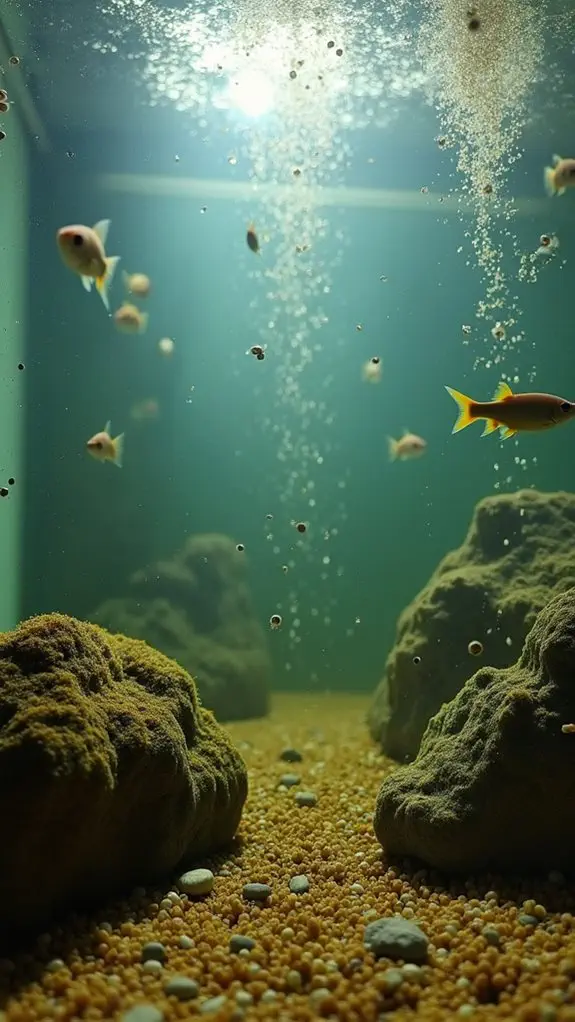
Fish population density plays an essential role in determining how often you'll need to vacuum your aquarium. Different fish species produce varying amounts of waste, and when you're keeping more fish, you'll naturally need to vacuum more frequently.
If you've got juvenile fish, you'll find yourself reaching for that vacuum even more often since they typically receive multiple feedings per day, leading to increased waste management needs.
You can give yourself a bit of a break by enlisting the help of a cleanup crew. Adding bottom-dwelling fish like cories will help keep waste levels in check, though they won't eliminate the need for regular vacuuming entirely. Think of them as your little underwater housekeeping team!
While maintaining proper vacuuming schedules is vital, you'll want to pair this with regular water changes to keep your aquatic friends healthy.
If you're noticing debris building up faster than usual, it's probably time to increase your vacuuming frequency. Remember, a clean tank isn't just about appearances – it's about creating a healthy environment where your fish can thrive without swimming through yesterday's leftovers.
Best Tools for Tank Cleaning
Having the right cleaning tools makes a world of difference when it comes to maintaining your aquarium. When you're equipped with the proper equipment, those algae removal techniques become much easier to master, and you'll find yourself actually looking forward to tank maintenance days.
Here's what you'll need in your aquarium cleaning arsenal:
- A quality magnetic cleaner, like the Aqueon or NEPTONION, which lets you tackle algae without getting your hands wet.
- A reliable vacuum siphon, which you can connect directly to your sink for effortless water changes.
- Long-handled tools, such as the versatile SEAOURA 7-in-1, perfect for reaching those tricky spots.
- Specialized tools like aquarium tweezers and soft toothbrushes for detailed cleaning.
For the best vacuum siphon tips, remember to hover the tube just above the gravel rather than digging deep, which helps prevent disturbing beneficial bacteria.
You'll also want to contemplate adding some natural cleaners to your tank – Amano shrimp and nerite snails are like tiny maintenance crews that work around the clock to keep your aquarium looking spotless between your regular cleaning sessions.
Plant Considerations
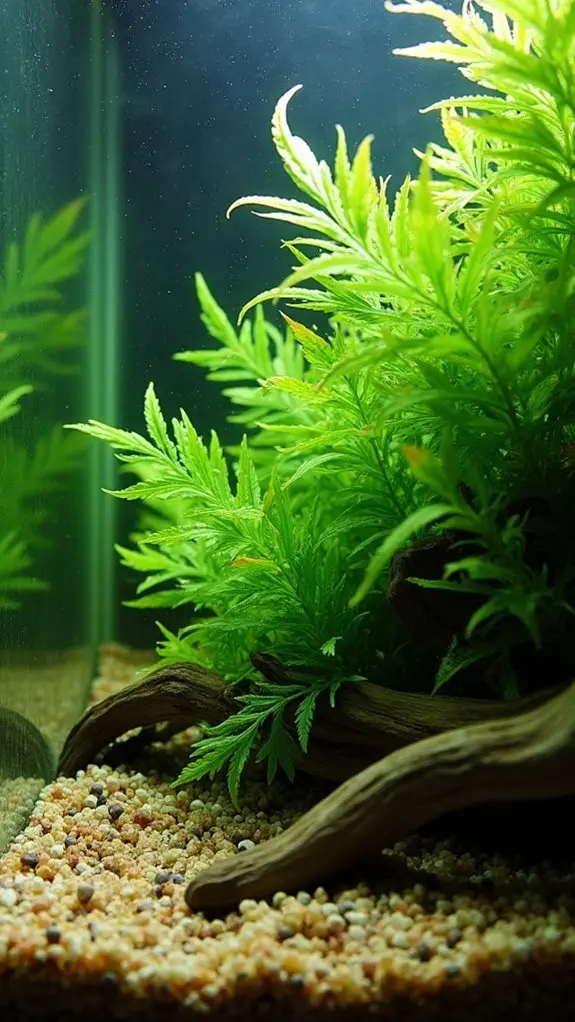
When you're planning your tank maintenance schedule, you'll need to take into account how densely planted your aquarium is, since more plants mean less frequent vacuuming.
Your aquatic plants work as natural filters, absorbing waste products and helping to keep the water clean through their biological processes.
If you've got a heavily planted tank, you can often reduce your vacuuming frequency to every other week, but you'll still want to check for debris around plant bases and remove any dead leaves.
Plant Density Affects Frequency
Plant density plays an essential role in determining how often you'll need to vacuum your aquarium. When you've got a heavily planted tank, the roots actually help with natural plant aeration, which means you mightn't need to vacuum as frequently.
Different substrate types designed for plants can also reduce your maintenance needs, as they work with the root systems to maintain a healthy environment.
Here's what you'll need to evaluate when deciding on your vacuuming schedule:
- Plant density level – denser plantings trap more debris but also process waste naturally
- Root system depth – deeper roots help aerate but can make vacuuming tricky
- Substrate depth – anything over 2 inches might need less frequent cleaning
- Plant types – species like hornwort and anacharis create complex root networks
You'll find that in heavily planted tanks, it's often better to focus on regular water changes rather than aggressive vacuuming.
If you're worried about waste buildup, contemplate adding some cleanup crew members like shrimp or snails – they're nature's little housekeepers!
Aquatic Plants Filter Naturally
Natural filtration represents one of the most valuable benefits of aquatic plants in your fish tank. When you're choosing plants, you'll find excellent options like Java Moss and Water Wisteria that work tirelessly to keep your water clean and healthy.
These plants don't just sit there looking pretty – they're actually nature's own filtration system!
You'll want to take into account plant compatibility when selecting your green helpers. Fast-growing options like Willow Moss and Bucephalandra are fantastic choices that'll actively filter your water while creating a beautiful underwater landscape.
If you're looking to tackle nitrate levels specifically, try adding some Anubias or even let plants like Pothos or Philodendrons grow out the top of your tank – they're incredible at removing those pesky nitrates!
The best part? Many of these plants are incredibly low-maintenance. Java Moss, for instance, is practically indestructible and will keep growing and filtering even if you forget about it for a while.
Just remember to match your plants to your tank's lighting conditions and water temperature, and you'll have a natural filtration system that's both functional and gorgeous to look at.
Safety During Tank Maintenance
The bucket and vacuum in your hands are powerful tools that require careful handling during tank maintenance. When you're performing these essential tasks, there are several safety precautions you'll want to follow to protect both you and your aquatic friends. Remember, you don't need to remove your fish during vacuuming – they'll actually feel less stressed staying put!
Here are your essential maintenance tips for safe tank cleaning:
- Position your bucket lower than the tank to guarantee proper siphoning and prevent backflow.
- Avoid using any harsh chemicals like glass cleaner or bleach – they're toxic to fish.
- Keep electrical equipment away from water splashes and spills.
- Use dechlorinated water for refilling to protect your fish's delicate gills.
When you're cleaning around decorations, move them carefully to access hidden debris.
You'll want to be extra gentle near planted areas to avoid disturbing roots while maintaining the tank's natural balance.
If you're working with deep substrate, don't dig too aggressively – focus on the top layer where most waste accumulates.
Frequently Asked Questions
Can I Vacuum My Tank Immediately After Adding New Fish?
You shouldn't vacuum immediately after adding new fish. Wait 24-48 hours to allow proper fish acclimation and maintain tank stability. Vacuuming too soon can stress your new fish and disrupt their settling process.
Does Vacuuming Remove Beneficial Bacteria From My Filter System?
No, you won't remove beneficial bacteria from your filter system through vacuuming. Your bacterial colonies are primarily established in your filter media, and regular tank maintenance doesn't disrupt these essential populations during routine cleaning.
Should I Vacuum Differently if I Have Bottom-Dwelling Fish?
You'll need to adjust your vacuum techniques around bottom-dwellers, being gentle and methodical. Work slowly in sections to avoid disturbing their fish habitat, and don't remove all debris as they rely on some particles.
How Long Should I Wait to Vacuum After Medicating My Tank?
Follow your medication's specific instructions first. If none are provided, you'll want to wait until your tank shows signs of recovery and stable water parameters before vacuuming, typically a few days after treatment ends.
Can Power Outages Affect My Tank's Vacuuming Schedule?
Power outages don't directly affect your tank's vacuuming schedule. You should maintain your regular tank maintenance routine unless emergency water changes are needed. Focus on oxygen levels and temperature stability during outages instead.
Final Thoughts
You'll find that regular tank vacuuming isn't just about keeping things tidy – it's essential for your fish's health and happiness. By sticking to a consistent schedule, using the right tools, and being mindful of your tank's specific needs, you're giving your underwater friends the best possible home. Remember, whether you're cleaning weekly or bi-weekly, it's all about finding that sweet spot between maintenance and letting your aquarium's natural ecosystem thrive.

